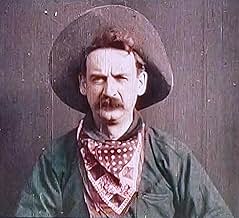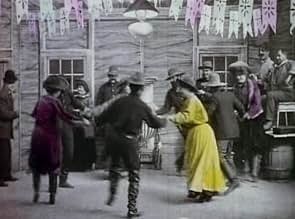IMDb RATING
7.2/10
22K
YOUR RATING
A group of bandits stage a brazen train hold-up, only to find a determined posse hot on their heels.A group of bandits stage a brazen train hold-up, only to find a determined posse hot on their heels.A group of bandits stage a brazen train hold-up, only to find a determined posse hot on their heels.
- Director
- Writers
- Stars
- Awards
- 1 win total
Gilbert M. 'Broncho Billy' Anderson
- Bandit
- (uncredited)
- …
A.C. Abadie
- Sheriff
- (uncredited)
Justus D. Barnes
- Bandit Who Fires at Camera
- (uncredited)
Walter Cameron
- Sheriff
- (uncredited)
John Manus Dougherty Sr.
- Fourth Bandit
- (uncredited)
Donald Gallaher
- Little Boy
- (uncredited)
Shadrack E. Graham
- Child
- (uncredited)
Frank Hanaway
- Bandit
- (uncredited)
Adam Charles Hayman
- Bandit
- (uncredited)
Robert Milasch
- Trainman
- (uncredited)
- …
Marie Murray
- Dance-Hall Dancer
- (uncredited)
Frederick T. Scott
- Man
- (uncredited)
Mary Snow
- Little Girl
- (uncredited)
- Director
- Writers
- All cast & crew
- Production, box office & more at IMDbPro
Featured reviews
As an early film, this film is quite spectacular. Ok, so it's only twelve minutes, but that is twelve minutes of pure action and entertainment. When this film was made, things like special effects were hardly thought of, but notice how well the transgression from person to doll on the "throw the dead guy off the train" goes, and how nicely they have "moved the train" without moving the camera when they leave the locomotive behind.
This movie is probably the best preview to how modern westerns became, at least if you take the best twelve minutes of many westerns, the twelve where people get shot, beat up and alerted. The movie follows it's storyline perfectly, and is easy to grasp the continuance throughout the film, in all, quite a masterpiece that comes highly recommended.
Christian Lockert
This movie is probably the best preview to how modern westerns became, at least if you take the best twelve minutes of many westerns, the twelve where people get shot, beat up and alerted. The movie follows it's storyline perfectly, and is easy to grasp the continuance throughout the film, in all, quite a masterpiece that comes highly recommended.
Christian Lockert
What can one say about an 11 minute film, which is reputed to be the first narrative motion picture to be shot in the United States? What does one compare it to when nothing had come before it? What is even more amazing is that parts of this movie are in color! The women's dresses at the dance are in color - each frame had been hand colored. The flashes from the barrels of the six shooters are red and an explosion sends up a riot of color. There is even a little girl in a red coat. Take that, Steven Spielberg!! Except for the last five seconds, all of the shots are in medium to long. The camera never moves. For each sequence, it is set in place and actors move in front of it.
It is a western, of course (shot in the wilds of New Jersey). A gang of bad guys knock out a train station clerk then board a departing train. They move to the car where there is a safe, blow the safe, stop the train and rob the passengers. Back in town, the clerk revives and tries to get help but passes out again. A little girl comes in wakes him up. The townspeople are having a dance when the clerk runs in to form a posse. The posse rides out and surrounds the gang, who is counting the loot in the woods. There is a gunfight and the robbers are killed. That is the whole story, but there is one short scene left - one of the most remarkable in film history. The all color episode lasts about 5 seconds. In medium close-up, a cowboy raises his pistol, points it directly at the camera, and fires three times. It is difficult for us to understand why this is here or what purpose it served. But when people who had never seen a movie before and didn't have any understanding of the technology first saw this man shooting at them, they screamed, fell to the floor, and ran for the door. It is also said that some in the audience pulled firearms and shot back. It is an early testament to the power that motion pictures had, even in its earliest incarnation. Thankfully, TCM ran TGTR without any modern musical accompaniment, as thousands must have seen it in the nineteen-aughts. I watched in total amazement. I was transported. Later, I reflected on how far movies had come and how little they had changed in the last 100 years. This movie is a priceless historical artifact that shows us just how much the past is still with us.
It is a western, of course (shot in the wilds of New Jersey). A gang of bad guys knock out a train station clerk then board a departing train. They move to the car where there is a safe, blow the safe, stop the train and rob the passengers. Back in town, the clerk revives and tries to get help but passes out again. A little girl comes in wakes him up. The townspeople are having a dance when the clerk runs in to form a posse. The posse rides out and surrounds the gang, who is counting the loot in the woods. There is a gunfight and the robbers are killed. That is the whole story, but there is one short scene left - one of the most remarkable in film history. The all color episode lasts about 5 seconds. In medium close-up, a cowboy raises his pistol, points it directly at the camera, and fires three times. It is difficult for us to understand why this is here or what purpose it served. But when people who had never seen a movie before and didn't have any understanding of the technology first saw this man shooting at them, they screamed, fell to the floor, and ran for the door. It is also said that some in the audience pulled firearms and shot back. It is an early testament to the power that motion pictures had, even in its earliest incarnation. Thankfully, TCM ran TGTR without any modern musical accompaniment, as thousands must have seen it in the nineteen-aughts. I watched in total amazement. I was transported. Later, I reflected on how far movies had come and how little they had changed in the last 100 years. This movie is a priceless historical artifact that shows us just how much the past is still with us.
The wild west. Tales of daring do on horse back. Such images conjured up by the term "wild west" conjure images of cowboys making peace with indians, train robberys, buffalo hunts and the indian wars. This term also conjures up law and order which, in that era a live by the sword and die by it venture. THE GREAT TRAIN ROBBERY captures the brutal lawless stories of the old west and translates it to film. Literally the film that started it all, this film proved story telling had moved from cave wall drawings, to pen and paper, and now celluloid. A great film for the era in which it was made and today as a historical heirloom. The GREAT TRAIN ROBBERY helped permanently capture the imagination of audiences everywhere.
Arguably the first motion picture to employ the milieu of what would quickly become known as the Western genre, Edwin S. Porter's The Great Train Robbery was a smashing success with audiences (dozens of film history texts report with glee how viewers shrieked with fear and delight when a tightly-framed gunslinger pointed and fired directly at the camera) and made remarkable strides toward the establishment of longer, more narratively developed films. Porter's cutting was also among the most sophisticated to date, as multiple locations and events were suffused with a previously unseen urgency. Based on actual events, The Great Train Robbery ignited the imaginations of the scores who saw it -- making the movie one of the earliest examples of sensationalized, fictionalized screen adaptations taken from historical precedent.
It's hard to assign "The Great Train Robbery" a rating, as it shouldn't really be watched as a film the way we watch films now. But from a historical perspective, it's fascinating, and is an excellent example of the use of film editing, an art form then in its infancy and now an award category recognized every year at the Oscars.
Before this movie, it wasn't customary to tell multiple story lines simultaneously, but here, various activities going on in different locations are intercut to create suspense. D.W. Griffith would use this technique much more ambitiously (and combine it with many other developing film techniques) in "The Birth of a Nation" over ten years later, but credit must be given to "Train Robbery" for blazing a trail.
Also, this is the movie famous for the shot of an outlaw shooting a gun directly at the camera. I can't imagine what effect this had on audiences at the time, who were probably diving behind their chairs for cover.
Grade: A
Before this movie, it wasn't customary to tell multiple story lines simultaneously, but here, various activities going on in different locations are intercut to create suspense. D.W. Griffith would use this technique much more ambitiously (and combine it with many other developing film techniques) in "The Birth of a Nation" over ten years later, but credit must be given to "Train Robbery" for blazing a trail.
Also, this is the movie famous for the shot of an outlaw shooting a gun directly at the camera. I can't imagine what effect this had on audiences at the time, who were probably diving behind their chairs for cover.
Grade: A
Did you know
- TriviaThe original camera negative still exists in excellent condition. The Library of Congress, who holds it, can still make new prints.
- GoofsWhen the telegraph operator revives with his hands tied behind his back, he uses one of his hands to help him stand up and then quickly puts the hand behind his back again.
- Alternate versionsThere is an Italian edition of this film on DVD, distributed by DNA srl, "CENTRO! (Straight Shooting, 1917) + IL CAVALLO D'ACCIAIO (The Iron Horse, 1924) + LA GRANDE RAPINA AL TRENO (The Great Train Robbery, 1903)" (3 Films on a single DVD), re-edited with the contribution of film historian Riccardo Cusin. This version is also available for streaming on some platforms.
- ConnectionsEdited into Hollywood: The Dream Factory (1972)
Details
- Release date
- Country of origin
- Languages
- Also known as
- L'attaque du Grand Rapide
- Filming locations
- Production company
- See more company credits at IMDbPro
Box office
- Budget
- $150 (estimated)
- Runtime11 minutes
- Sound mix
- Aspect ratio
- 1.33 : 1
Contribute to this page
Suggest an edit or add missing content
























